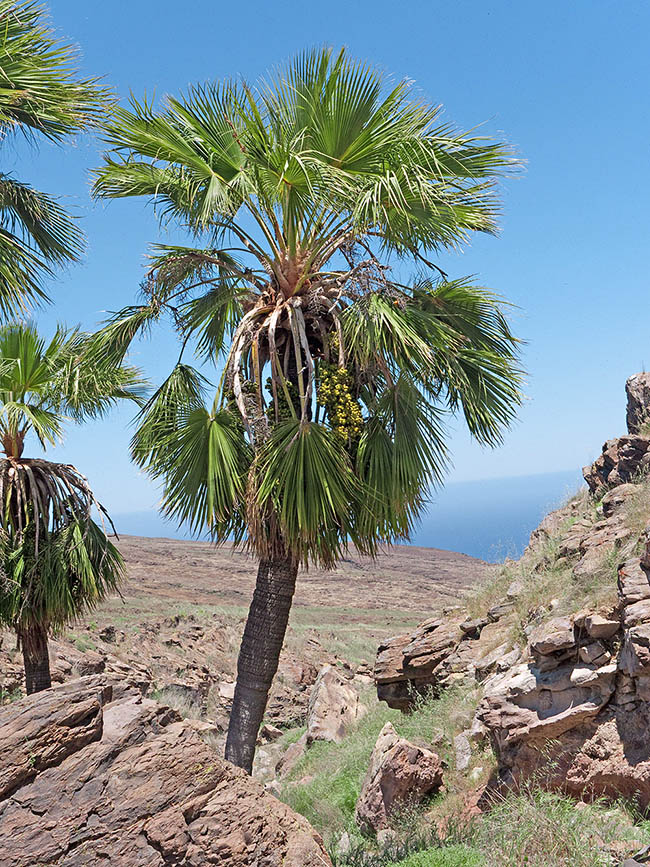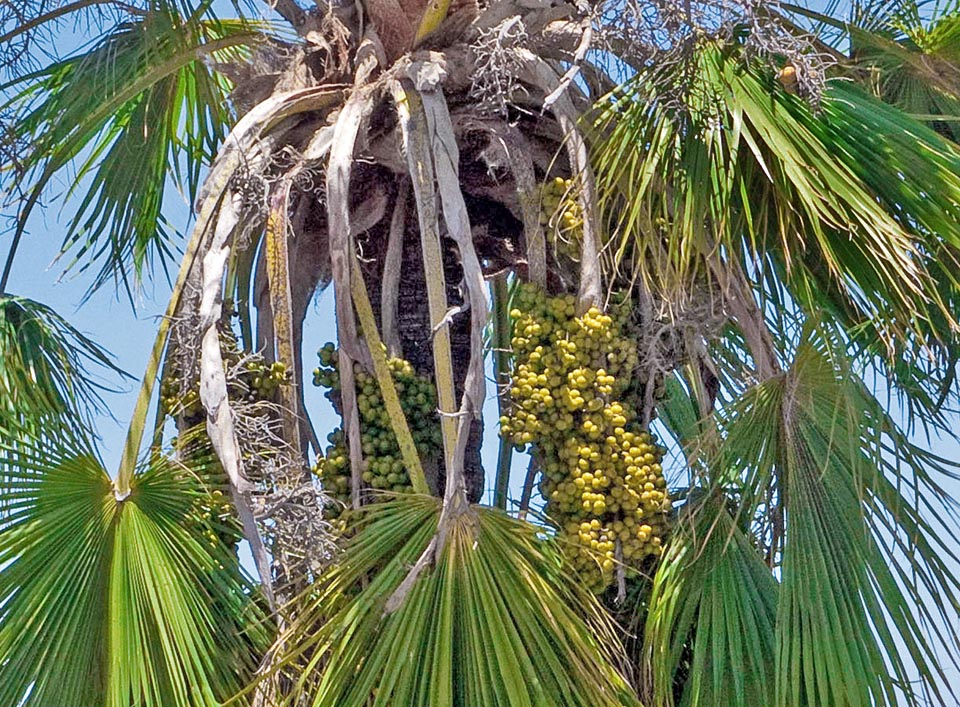Family : Arecaceae

Text © Alessandro Marini

English translation by Mario Beltramini

Endemic to Guadalupe Island, Brahea edulis reaches the height of 12 m © Alan Harper
Brahea edulis H.Wendl. ex S.Watson is endemic to the island of Guadalupe, off the western Mexico coast. It is found on the steep and rocky slopes of volcanic origin, in the foggy north-western side of the island.
The name of the genus Brahea is dedicated to the Danish astronomer Tycho Brahe (1546-1601). The name of the species edulis comes from the Latin “edo”, to eat and refers to the seeds, considered edible.
Common names: Guadalupe Palm (English), Palma de Guadalupe (Spanish).
Brahea edulis has a solitary stem, up to 12 m tall and up to 40 cm broad, of dark grey colour, marked by vertical and horizontal fissures, the latter placed in correspondence of the fallen leaves. Under the top the stem is covered by the brown fibres present at the bases of the petioles that persist for a short time together with the withered leaves.
The foliage is up to 4 m broad and is formed by 20/30 circular leaves, divided per one third of their length and moderately costapalmate, very coriaceous, of dark or medium green colour. The leaves are up to 1 m long, carried by up to 1 m long yellow-green petioles with the borders armed by short thorns.
Brahea edulis is a monoecious species presenting inflorescences on two orders, up to 1,2 m long, shorter than the leaves and poorly visible through the foliage. The male and female flowers are yellow.
The spherical fruits are about 3,5 cm broad, of olive green colour turning black when ripe.
It propagates by seed that, if taken just ripe, takes 3 to 5 months to germinate, placed at 25 °C. After ripening the germination gets slower and it is necessary to soak the seeds in hot water for 24 hours in order to accelerate the germination. The seed produces a long taproot before the leaflets, then must be planted in deep pots or planted directly. The rate of growth of the seedlings is slow.
Brahea edulis is a palm very known in cultivation due its great adaptability to different climates and environments and for its robustness.
It vegetates well on all sorts of soils, even the poor ones in terms of nutrients, provided well-draining. Once settled in its final position it stands well the drought. It always requires an exposition in full sun and wilts if located in shady positions. Given the area of origin, it better bears the atmospheric humidity than its congener and equally well known Brahea armata and is very resistant to winds and the marine aerosol.
It can be cultivated in different climatic zones, from the tropics to the temperate zones where it can withstand frosts up to -7 °C, if kept in full sun.

Endangered species, has a 4 m cyme with 20-30 circular leaves, divided per one third of length. The fruits are edible, and unluckily also the fresh apical bud © Alan Harper
This species can be transplanted quite easily also when adult, with several metres of stem. In such a case, even if the thick flesh roots break up and get dry during the transplant, the plant will issue new ones quickly. It is important to stabilize the specimen well by means of solid support posts and to often give water, until the vegetative regrowth. Also, it helps the elimination of the leaves of the cyme, in order to decrease the transpiration after the transplant.
In 2021, Brahea edulis was assessed by the IUCN Red List of Threatened Species in the category of “Least Concern” (LC, Least Concern). At the beginning of the 19th century, the importation of goats by settlers on the island of Guadalupe resulted in the difficulty of multiplication of this species due to the continuous collection of young new-borns over the years. This phenomenon also affected all the other tree species of the native flora of Guadalupe, such as the Guadalupe cypress (Cupressus guadelupensis), and changed the original environment of the island from the initial widespread forests to the current rocky hills. Since the end of the 20th century, a project to eradicate feral goats has been implemented, and this project ended in 2005. As a result, both Brahea edulis and the other tree species of the island are resuming colonizing the abandoned areas.
The local population usually consumes the fruits of the palm fresh or utilizes them to make preserves. Also the apical young bud is consumed cooked as well as fresh in salad.
Synonyms: Erythea edulis (H.Wendl. ex S.Watson) S.Watson.
